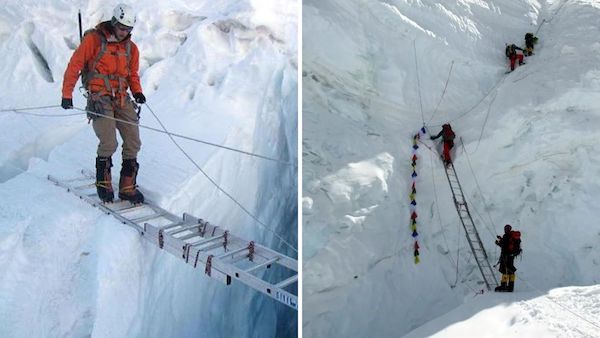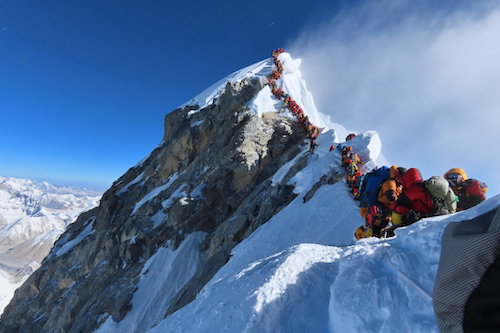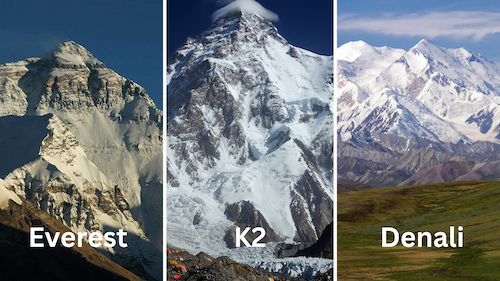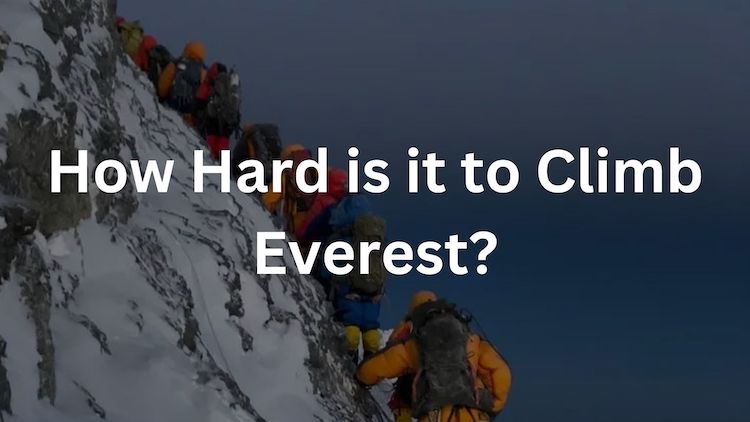It is extremely difficult to climb Everest. Climbing Mount Everest is considered one of the most challenging and dangerous endeavors in the world of mountaineering. The difficulty of climbing Everest arises from a combination of factors, including length of time to climb of Everest, extreme altitude, unpredictable weather conditions, long and physically demanding ascents, technical climbing challenges, and the need for proper acclimatization.
Before attempting the ascent to the top of Everest, it is necessary for climbers to undertake a trek to Everest Base Camp, situated at an elevation of 5,100 meters. As part of the acclimatization process, most climbers choose to trek through the Renjo La pass and Chola pass. They then spend several nights in the Gokyo valley, where they summit Gokyo Ri and Kala Patthar before finally making their way to Base Camp. This carefully planned route helps them adapt to the altitude and prepare for the challenging climb ahead.
Why is it so Hard to Climb Everest?

Everest is difficult to climb because it requires 6-8 hours of daily walking and then 10-12 hours of climbing and camping each day. Combined with its extreme altitude, unpredictable weather, and dangerous terrain, Everest is one of the hardest and most dangerous mountains to climb.
The difficulty of climbing Everest arises from a combination of elements, here are the key factors that make climbing Everest so hard:
1. High altitude:
One of the main obstacles faced while climbing Mount Everest is the high altitude, which can lead to various health issues, including altitude sickness. At such extreme elevations, the air becomes thin, resulting in reduced oxygen availability for the body, leading to symptoms such as dizziness and headaches. To cope with this challenge, climbers utilize supplementary oxygen during their ascent.
Furthermore, the region above 8,000 meters (26,246 feet) is known as the death zone due to the significantly increased risk of altitude-related problems. At this height, the oxygen level drops to only one-third of what is found at sea level, increasing the likelihood of high-altitude cerebral edema (HACE). As a result, proper acclimatization is absolutely crucial for climbers attempting to reach higher altitudes safely. The table below shows the different oxygen levels compared to altitude.
| Altitude | Oxygen Level |
|---|---|
| Sea Level | 100% |
| 1,000m / 3,281ft. | 88% |
| 2,500m / 8,202ft. | 73% |
| 3,000m / 9,843ft. | 68% |
| 3,500m / 11,483ft. | 64% |
| 4,000m / 13,123ft. | 60% |
| 4,500m / 14,764ft. | 57% |
| 5,000m / 16,404ft. | 53% |
| 5,500m / 18,044ft. | 50% |
| 6,000m / 19,685ft. | 47% |
| 6,500m / 19,685ft. | 44% |
| 7,000m / 22,966ft. | 41% |
| 8000m / 26,247 ft. | 36% |
| 8,848m / 29,028ft. | 33% |
2. Extreme Weather:
Climbers face a significant challenge due to the extreme weather conditions that can change instantly. The temperatures on Mount Everest can be harsh, ranging from lows of -33F (-36C) to highs of over -2F (-19C) during summer. Moreover, the weather is highly unpredictable, characterized by high winds and heavy snowfall that intensify the risks and hazards of climbing. As climbers ascend in elevation, the severity of the weather increases exponentially.
3. Physical Fitness and Demands:
Physical fitness is another crucial element that contributes to the difficulty of climbing Everest. The ascent is incredibly demanding, requiring a high level of fitness. Even seasoned climbers must possess excellent physical condition to cope with the effects of high altitude, harsh weather, and rugged terrain. Endurance is key as the climb entails enduring exhaustive days of climbing of 10 hours or more while carrying a heavy pack.
4. Technical Difficulties:

The path to the summit of Mt. Everest is characterized by steep and rocky terrain, featuring sections that demand technical climbing expertise – such as the second step on the North Col, or the difficult Hillary step. Negotiating these segments can prove particularly challenging, especially for inexperienced climbers, and even those with experience may encounter significant risks. Moreover, the route is frequently congested with other climbers, further complicating maneuverability and raising the likelihood of accidents.
5. Risk of Avalanches:
Mt. Everest experiences frequent avalanches, which can be triggered by various factors, including abrupt weather changes, the movement of other climbers, and the shifting of snow and ice on the mountain. These avalanches pose a significant challenge as they can result in severe injuries and even fatalities. Moreover, they can obstruct or bury crucial routes to the summit, creating obstacles for climbers.
Additionally, the Khumbu Icefall, presents a significant risk due to the potential of serac falls. Seracs are massive blocks of ice that form as a result of crevasses and fractures within the glacier. Their unpredictable nature makes them highly dangerous, as they can collapse or break apart without warning. Climbers and Sherpas navigating through the Khumbu Icefall are constantly at risk of being caught in a cascading serac collapse, leading to severe injuries or fatalities.
6. Crowds and Logistical Challenges:
Climbing Mount Everest has become increasingly challenging due to the growing crowds and logistical hurdles. The surge in climbers has led to dangerous bottlenecks at critical sections, posing risks of accidents and delays. Limited resources and infrastructure strain further add to the difficulties, making thorough preparation and organized expeditions essential for safe and successful ascents. Below is a picture from Nimsdai in 2019 showing the crowds and bottleneck on Everest.

7. Acclimatization Process:
Mount Everest is renowned for the demanding process of acclimatization the mountaineers have to go through. Climbers must spend several weeks acclimating to the high altitude, gradually ascending and descending the mountain to help their bodies adapt to the thin air.
This slow and methodical process is essential to reduce the risk of altitude-related illnesses and prepare physically and mentally for the challenges ahead. The prolonged exposure to extreme altitudes and harsh conditions can take a toll on the climbers’ bodies, making the process of acclimatization both crucial and difficult.
How Hard is Everest Base Camp Trek?
The Everest Base Camp trek is considered challenging but achievable for individuals with a moderate level of fitness and determination. While it is not a technical climb, it involves hiking through high altitudes and varied terrain, which can be physically demanding.
The trek usually takes around 12-14 days, covering a distance of approximately 130 kilometers (80 miles) round trip from Lukla to Everest Base Camp and back. The main difficulty lies in the altitude. The trek reaches a maximum elevation of 5,364 meters (17,598 feet) at Everest Base Camp.
Despite the challenges, the Everest Base Camp trek is a popular adventure, and thousands of trekkers successfully complete it every year. With proper preparation, a good trekking itinerary, and the support of experienced guides and porters, the trek’s difficulty can be mitigated and made easier for novice climbers
How Many People Have Climbed Everest?
As per the Himalayan Database, slightly above 6,000 individuals have successfully climbed Mount Everest. However, the total number of ascents stands at over 11,000, with Nepalese climbers contributing 5,700 of those ascents. It’s important to note that this figure includes mountaineers who have participated in multiple expeditions.
Since the historic first summit by Edmund Hillary and Tenzing Norgay in 1953, there have been more than 11,850 successful summit ascents. Despite its popularity, conquering Mount Everest is far from easy. To learn more, check out our blog on how many people have climbed Everest.
How Many Climb Everest Each Year?
The number of people attempting to climb Mount Everest annually is approximately 800. Beyond that, Sagarmatha National Park attracts around 100,000 visitors each year, with approximately 500 individuals journeying to the Everest Base Camp on a daily basis.
In 2018, there was a record-breaking number of successful summits, with around 800 climbers reaching the peak, surpassing the previous record of 667 climbers in 2013. Up to July 2022, the mountain has witnessed approximately 11,346 successful summit ascents accomplished by 6,098 individuals.
How Long Does It Take To Climb Everest?
Typically, the entire expedition, including the trek to Everest Base Camp and the climb to the summit, can take around two to three months.
The trek to Everest Base Camp alone usually takes about 12-14 days, covering a distance of approximately 65 kilometers (40 miles) from Lukla to Base Camp and back. Climbers spend additional weeks at Base Camp to acclimatize to the high altitude, gradually ascending and descending the mountain to allow their bodies to adjust to the thin air.
The final push to the summit involves several rotations between the higher camps and the summit bid. This process allows climbers to progressively acclimatize and improve their chances of reaching the summit safely. The time spent on the higher camps depends on weather conditions, acclimatization progress, and overall expedition planning.
On average, the actual climb from Base Camp to the summit and back can take around 4-5 days, but climbers may need to wait for a suitable weather window to make their summit attempt, which can add extra days or even weeks to their overall Everest expedition duration.
How Much is it to Climb Everest?
Climbers planning to ascend Mount Everest can anticipate a wide range of expedition costs, spanning from $32,000 (USD) to $200,000, depending on factors such as expedition type, inclusions, and desired level of luxury.
Considering the financial burden, the cost may be the most difficult aspect of climbing Everest for many. Whereas, based on pricing data from ExpedReview for 2023, the average expedition cost to Everest is $58,069, with a median price of $50,000. However, when excluding private trips and flash expeditions, which tend to be significantly pricier, the average cost drops to $52,448, with a median of $49,500.
To see a full rundown on costs associated with climbing Everest, have a look at our how much does it cost to Everest blog.
Which Everest Summit Route is the Hardest and Easiest to Climb?
The two primary routes to the summit of Everest are the South Col route and the North Col route. The South Col Route, beginning from the Nepalese side of the mountain, is considered the easiest and safest path. This route provides a direct and relatively straightforward line to the summit, making it an attractive choice for climbers.
Each route has its own set of challenges, and the difficulty can vary depending on the climber’s experience. Below is a more indepth account of how difficult the two different routes are.
Everest’s South Col Route:
The South Col route, also known as the Southeast Ridge route, is the most popular and commonly used route to the summit. It starts from the Nepal side and involves ascending through the Khumbu Icefall, the Western Cwm, the Lhotse Face, and the South Col. The final push to the summit involves climbing the Hillary Step.
While this route is more accessible and has more established infrastructure (such as camps and fixed ropes), it still presents significant challenges, particularly in the Khumbu Icefall, where climbers must navigate through dangerous and technical crevasses and seracs.
Everest’s North Col Route:

The North Col route, also known as the North East Ridge route, starts from the Tibet (China) side of Everest. This route involves ascending through the Rongbuk Glacier, the North Col, the North Ridge, and the Three Steps. The North Col route is generally considered more technically demanding than the South Col route, with steeper and more exposed sections, especially in the Three Steps. However, this route often has less traffic and can provide a more secluded and adventurous climbing experience.
North Col and South Col Comparison:
In terms of objective difficulty, the North Col route may be considered the hardest due to its technical challenges.
However, it’s important to note that the weather, conditions on the mountain, and individual climber’s abilities can play a significant role in determining the difficulty of either route. Both routes require extensive mountaineering experience, excellent physical fitness, and proper acclimatization to safely attempt the climb.
Comparing The Difficulty To Climb Mt. Everest, Mt. K2 and Mt. Denali:

Mount Everest, Mount K2, and Mount Denali present formidable challenges to climbers. Everest, is renowned for its extreme altitude and harsh weather. Similarly, K2, the second-highest peak, is infamous for its steep terrain and unpredictable weather conditions. Meanwhile, Mount Denali, the highest in North America, poses difficulties due to its high elevation and ever-changing weather.
Climbing any of these three mountains requires exceptional physical fitness, extensive experience, and unwavering determination. While the K2 expedition is considered the toughest and deadliest among them, Everest remains a demanding climb due to its extreme altitude. Mount Denali, though relatively easier than K2, still surpasses Everest in difficulty due to its demand for technical mountaineering ability.
The table below provides a concise comparison of these remarkable peaks:
| Mountain | Mount Everest | K2 | Mount Denali |
|---|---|---|---|
| Location | Nepal | Pakistan | North America |
| Altitude | 8,848 m (29,030 ft) | 8,611 m (28,251 ft) | 6,190 m (20,310 ft) |
| Minimum Temperature (approx.) | -36C / -33F | -25C / -31F | -60C / -75F |
| Climb Duration (approx.) | 70 days | 60 days | 18 days |
| Difficulty to Climb | Hard | Extreme | Hard |
| Key Challenges | Extreme altitude, harsh weather | Steep, treacherous terrain, unpredictable weather | Frequently changing weather, Technical climbing |
Key Takeaways: How Hard is it to Climb Mount Everest?
Mount Everest stands as an immensely challenging peak to conquer, requiring exceptional physical fitness, mental fortitude, and expert acclimatization to cope with its extreme altitude, treacherous terrain, and unpredictable weather. Although over 11,850 successful summit ascents since 1953 have been completed, the over 200 bodies on Everest makes it evident that Everest’s difficulty should not be underestimated.
So although some people like Maurice Wilson don’t even question how hard it is to climb Everest, and set out to crash land on the mountain and summit with no mountaineering experience, the ascent is actually one of the most demanding climbs in the world. Climbers embarking on this journey must be prepared to face months of rigorous preparation, acknowledging the inherent risks and uncertainties that accompany the expedition.
While being an alluring and popular climb, Mount Everest is far from a “piece of cake,” demanding unwavering dedication from those seeking to reach its iconic summit.
FAQs: How Hard is it to Climb Mount Everest
Below are some of the most frequently asked questions when it comes to questioning how difficult it is to climb Mt. Everest.
Climbing Mount Everest is immensely challenging. Despite its reputation, there are mountains of lesser height than Everest that pose even greater difficulties for climbers. Only seasoned professionals, having acclimatized to high altitudes, achieved success on other challenging peaks, and strengthened their bodies to cope with reduced oxygen levels, can realistically consider planning an ascent of Everest.
Climbing Everest with no experience is extremely challenging and is not recommended. Reaching the summit of Mount Everest demands years of mountaineering experience and expertise. However, trekking to Everest Base Camp (EBC) is entirely accessible to individuals with no mountaineering background or technical skills.
Climbing Everest as a beginner without adequate mountaineering experience is deadly and strongly discouraged.
Those venturing into the high mountains must possess both physical fitness and mental readiness. It usually takes at least a year of intense training before individuals are adequately prepared to climb Mount Everest.
